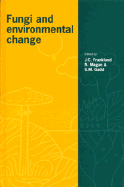Book contents
- Frontmatter
- Contents
- List of contributors
- Preface
- 1 Effects of climate change on fungal diseases of trees
- 2 Effects of climate change on Fusarium foot rot of winter wheat in the United Kingdom
- 3 Effects of UV-B radiation (280–320 nm) on foliar saprotrophs and pathogens
- 4 Implications of global warming and rising sea-levels for macrofungi in UK dune systems
- 5 Red Data Lists and decline in fruiting of macromycetes in relation to pollution and loss of habitat
- 6 Effects of dry-deposited SO2 and sulphite on saprotrophic fungi and decomposition of tree leaf litter
- 7 Effects of atmospheric pollutants on phyllosphere and endophytic fungi
- 8 Influences of acid mist and ozone on the fluorescein diacetate activity of leaf litter
- 9 Mycorrhizas and environmental stress
- 10 Myccorhizas, succession, and the rehabilitation of deforested lands in the humid tropics
- 11 Potential effects on the soil mycoflora of changes in the UK agricultural policy for upland grasslands
- 12 Uptake and immobilization of caesium in UK grassland and forest soils by fungi, following the Chernobyl accident
- 13 Effects of pollutants on aquatic hyphomycetes colonizing leaf material in freshwaters
- 14 Fungi and salt stress
- 15 Fungal sequestration, mobilization and transformation of metals and metalloids
- 16 Urban, industrial and agricultural effects on lichens
- 17 Fungal interactions with metals and radionuclides for environmental bioremediation
- 18 Impact of genetically-modified microorganisms on the terrestrial microbiota including fungi
- 19 Has chaos theory a place in environmental mycology?
- Index of generic and specific names
- Subject index
19 - Has chaos theory a place in environmental mycology?
Published online by Cambridge University Press: 05 November 2011
- Frontmatter
- Contents
- List of contributors
- Preface
- 1 Effects of climate change on fungal diseases of trees
- 2 Effects of climate change on Fusarium foot rot of winter wheat in the United Kingdom
- 3 Effects of UV-B radiation (280–320 nm) on foliar saprotrophs and pathogens
- 4 Implications of global warming and rising sea-levels for macrofungi in UK dune systems
- 5 Red Data Lists and decline in fruiting of macromycetes in relation to pollution and loss of habitat
- 6 Effects of dry-deposited SO2 and sulphite on saprotrophic fungi and decomposition of tree leaf litter
- 7 Effects of atmospheric pollutants on phyllosphere and endophytic fungi
- 8 Influences of acid mist and ozone on the fluorescein diacetate activity of leaf litter
- 9 Mycorrhizas and environmental stress
- 10 Myccorhizas, succession, and the rehabilitation of deforested lands in the humid tropics
- 11 Potential effects on the soil mycoflora of changes in the UK agricultural policy for upland grasslands
- 12 Uptake and immobilization of caesium in UK grassland and forest soils by fungi, following the Chernobyl accident
- 13 Effects of pollutants on aquatic hyphomycetes colonizing leaf material in freshwaters
- 14 Fungi and salt stress
- 15 Fungal sequestration, mobilization and transformation of metals and metalloids
- 16 Urban, industrial and agricultural effects on lichens
- 17 Fungal interactions with metals and radionuclides for environmental bioremediation
- 18 Impact of genetically-modified microorganisms on the terrestrial microbiota including fungi
- 19 Has chaos theory a place in environmental mycology?
- Index of generic and specific names
- Subject index
Summary
Introduction
Chaos theory, which strictly is only a subset of non-linear systems theory, deals with systems whose long-term behaviour or output is prone to be complex, irregular, sensitive to small changes in initial conditions and unpredictable at specific localities. Amongst several recent texts that have aimed to popularize the theory and describe its remarkable history, those by Gleick (1988) and Coveney & Highfield (1991) are perhaps the most accessible. More detailed sources of information concerning specifically biological applications of nonlinear theory are provided by Degn, Holden & Olsen (1987) and by Sleeman (1989).
The aim of this chapter is to promote appreciation of the ways in which non-linear dynamics can be expected to apply to fungal individuals, populations and communities. It will be argued that non-linear theory has more than just a place in environmental mycology; it provides a basis for understanding the complexity, interconnectedness and limits to the predictability of natural patterns of distribution and activity of fungi.
Throughout the discussion, the focus will be on understanding of the sources and ecological importance of non-linearity, rather than on rigorous mathematical treatment. At the outset, an attempt will be made to generalize about the kinds of process which underlie non-linear dynamics and the organizational properties that these processes give rise to. The mechanisms by which these processes operate at individual, population, community and sub-cellular levels of organization will then be considered and related to the ways that fungal systems respond to sources of environmental heterogeneity.
- Type
- Chapter
- Information
- Fungi and Environmental Change , pp. 317 - 341Publisher: Cambridge University PressPrint publication year: 1996
- 6
- Cited by

